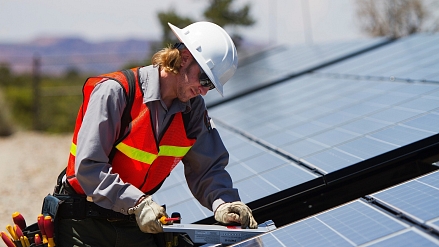Wind direction and tilt angle approach to keeping panels cool
A technique proposed by scientists in the United Stated could raise solar plant output 5% and decrease panel degradation by more than 0.3% per year, according to the researchers. The approach is based on wind direction and speed, and module inclination.

Researchers from Portland State University claim to have developed a method of raising solar plant energy yield around 5% while reducing panel degradation by more than 0.3% per year.
The academics have developed a convective cooling approach of keeping solar system temperatures down which takes into account wind direction and speed and module inclination. “Until now, no scaled platform has existed for studying enhancements at the array level,” the scientists stated. “Through this new lens, we examine the fluid flow and heat transfer in a large scaled solar array, beginning with fundamental parameters of inclination angle and wind speed.”
Wind direction
The group analyzed which module inclination angles could influence convection heat transfer and the related fluid mechanisms which drive heat transfer. They found a 45% growth in convective heat transfer coefficient was possible, depending on wind direction.
The Portland group suggested solar plant developers consider predominant wind direction and sub-panel flow when designing projects. “One example in which a solar farm may be able to optimize for this in the design stage, would be to use a larger E-W (east-west) direction compared to the N-S direction, in the case that the predominant wind comes from the north or south,” said the researchers.
Inclination angles of 15, 30, 45, and −30 degrees were chosen for testing. The researchers said the extent of cooling depends on how incoming airflow is divided into array flow – which passes under and between panels – and bypass flow, which at most only slightly interacts with an array.
Negative angle
At −30-degree inclination, panels act as downward baffles, the scientists said, channeling air under the modules which would otherwise have been deflected up over them. “The net effect is that an increased volume of fluid interacts with the panels, compared with the 30-degree case,” the researchers stated.
Although maximum heat transfer could be achieved at an optimum negative inclination, according to the Portland Group, the researchers did not recommend angling panels at −45 degrees or an higher negative inclination.
“A 30-45% increase in convective heat transfer coefficient was observed when the incoming flow direction shifts 180 degrees to face the rear surface of the PV panels,” the scientists added. “This increase corresponds to a 5-9 degrees Celsius decrease in PV module temperature.”
The Portland group said factors such as panel row spacing, height of panel and other structures or layouts which could enhance flow channeling through solar plants, should be analyzed to improve their proposed approach.
